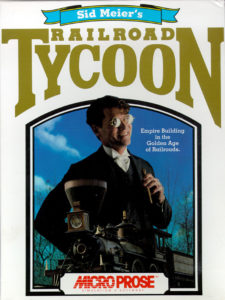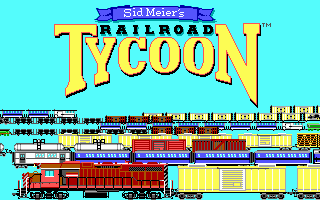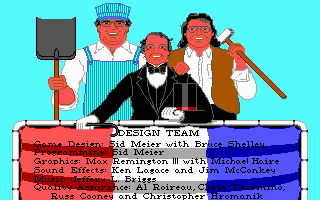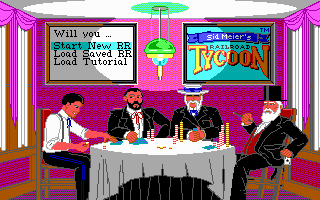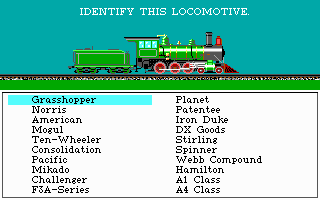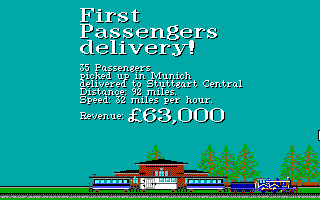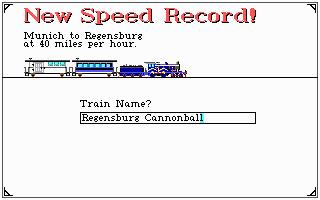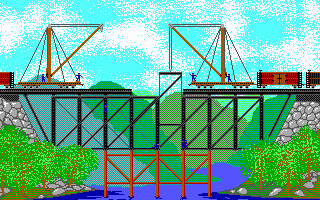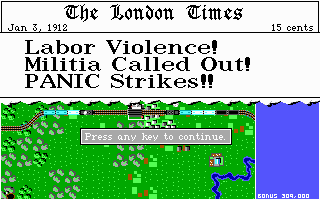Sid Meier’s Railroad Tycoon description
The founder of the subgenre of "economic strategies" and the first game with the marketing prefix "Sid Meier's" (which three years before " Pirates!"it was still not completely official), "Railroad Tycoon" is actually the creation of three employees of MPS Labs-the internal design division of the company MicroProse, which produced at that time almost all simulators of various military equipment. Sid Meyer, who really was the main author of the idea, was going to take a little break from planes and submarines and just play "steam trains", having embodied with the help of the latest computer technologies the favorite entertainment of many children around the world; however, his colleague Bruce Shelley, true to his desire for realism and historical authenticity, saw this idea as an opportunity to open up the prospect of the player to lead a real railway company during the "Golden era" of this type of transport and compete in the large-scale construction of the nation's rail arteries with other magnates-just like in the Board games of the series " 1829 "and" 1830", one of which Shelley himself managed to work on in his time. All this variety of ideas was realized in the end in "Sid Meier's Railroad Tycoon", thanks also to the third co-author-artist max Remington.
The graphics turned out to be a maximum of 16-color, but very pleasant: the trailer of each type flaunts its own shade and style, the details of pixel locomotives are made very accurately and accurately, but most of all, various optional inserts and animations like the construction of bridges, as well as close-UPS of stations shown when they are built or when the first trains arrive on them. However, most of the time we will see a global map that does not particularly claim to be picturesque. Those in game four, in accordance with existing campaigns: start creating a train Empire in the Eastern United States in 1830; the rest of the territory of this country in 1866 (the border is the Great Lakes region, partially present in both maps); the home of the steam locomotives in England, 1828; and in Europe in 1900 and then (with much of the same England, a piece of Northern Spain, with Chisinau, Kiev, Vinnitsa, Minsk and even Lviv and Kaunas, but without Moscow or St. Petersburg).
Having founded a railway company-traditionally named by default after the first two connected cities-you will need to hold on to the position of its head for exactly one hundred years. In addition to the historical era, at the beginning, the desired level of complexity is selected, from "investor" to "tycoon", as well as three important accompanying parameters that determine the degree of realism and possible obstacles to our peaceful activities (and which can be turned off or turned on at any time of the game, adding a certain percentage to your final rating with the last action). First, there is the possibility of a train collision: when it is activated, you will have to manage almost all semaphores manually and personally, not trusting this important matter to an automatic dispatcher; second, the" simple "or" complex " economy: in the first case, each city on the map will be happy to purchase any goods we deliver, and in the second – only according to the current poor list of preferences; third, the local competition can be both "friendly" and "fierce". The fact is that in addition to our company on the same map, three more entrepreneurs will try to build their railway empires – and represented by quite historical figures: in the United States or England, these are famous magnates, financiers or inventors like John Pierpont Morgan, Cornelius Vanderbilt, Jay Gould and Robert Stephenson, and in Europe, for some reason, all political figures of different eras – such as Napoleon III, Benito Mussolini, Otto Bismarck, Nicholas II and Vladimir Ilyich Lenin. It is difficult to say what caused this choice of characters; for example, about the activities of S. Yu. Witte Bruce Shelley, who compiled an excellent user's guide full of technical details, historical references, and references, is well aware of this. In any case, when choosing a" friendly " relationship on the part of competitors, they will not start price wars and try to take control of our company through stock speculation – although nothing will prevent us from trying to do the same with them.
But first, we lay our first paths (in a very clever way, using a small numeric keypad – be sure to get acquainted not only with the mentioned user guide, but also with the technical Supplement to it!), building stations (a small "depot" costs 50 thousand dollars. the mid-level "station" and the huge "terminal" are two and four times more expensive, respectively; in the future, various improvements such as a hotel, restaurant or car repair shop are possible) - and, of course, we buy rolling stock. The choice of locomotives is small at first, and in the 1820s and 30s is reduced to a single American or European model, not at all impressive in its technical characteristics, but gradually, through the headlines appearing on the screen, we will learn about the latest inventions in the field of railway engines and, if desired, and as necessary, due to the wear and tear of old models, replace our well-deserved locomotives with new ones. The choice of cars and routes is more complicated: each addition to the train composition not only reduces the speed and maneuverability of the train, but is designed to transport only one type of cargo: from mail and passengers - to grain, wine or oil (the United States, England and Europe differ somewhat in the range of available resources).
"Railroad Tycoon" tries to make it easier for a novice tycoon to plan logistics: we have as many as four levels of map scaling, from the global-geographical map, called using the F1 key, to the more or less detailed map (F4), where you can only perform all your creative actions; the two intermediate scales differ in schematic images of supply and demand (especially useful in the "complex" economic mode) from cities and enterprises scattered here and there: sawmills, mines, cattle yards, etc. – both those that are on the map initially, and those that appear later in a more or less random order; however, such farms can be opened independently, in addition to the main railway business (for example, if the cars loaded from the sawmill systematically refuse to generate income, it makes sense to build a paper factory somewhere nearby). The F6 key displays a list of all our trains, indicating both their composition and the revenue generated; F7 allows you to create a new train, and F8-to build a station (but only on ready-made tracks connected to existing sections of our railway; both trains and terminals with depots are allowed to have no more than 32 pieces). When creating paths on a new territory, it is recommended to call a team of engineers-surveyors using F10: in this case, the two-dimensional map will be covered with a designation of the landscape heights: ascents and sharp turns should be avoided in every possible way; however, the game in any case will not allow laying rails at the wrong angle and will require confirmation at a height difference of at least 1.5%, and when summing up paths to hills, mountains, rivers or lakes, it will carefully offer to build a bridge or tunnel (if, of course, the company's cash register has enough cash for this).
Financial issues, as you might expect, are a very important aspect of "Sid Meier's Railroad Tycoon". Initially, our capitalization is $ 1 million – one half of this amount is received from sales of 4% bonds (which will have to be repaid, and if you want, you can buy back and issue a new edition), and the second half is made up of contributions from the company's shareholders. It is these invisible citizens who act as our unspoken superiors, regularly monitoring the cost of shares and profits from transportation; once every two years – this is how long the fiscal period lasts here – we are given a General accounting report on assets and liabilities, income and expenses (available at any other time by pressing F5), as well as on the mood of shareholders, our positions relative to competitors and-a pleasant legacy of " Pirates!"with his" hall of fame "- about job prospects in the event of dismissal from his current position, from "tramp" to "train conductor", "army captain", "state Governor" and (crown of evolution) "us President". You can finish the game according to the plan – retiring after the stated century of fruitful work - and at will (by selecting the "Retire" command in the "Actions" menu), and by the decision of the Board of shareholders (in the case of a long period of losses and falling stock prices, which is equivalent to an unsuccessful and premature end of the game).
You can avoid this last scenario by playing on the stock exchange (the F9 key is responsible for communicating with the broker). If you regularly buy back shares of your own company (at a price slightly higher than the market price), it is possible to accumulate a large part of them, after which no one can dismiss us from the post of head of the whole business. It is also allowed to purchase similar securities of competitors, in different volumes depending on the level of complexity.the owners of a controlling stake in other companies will have some new opportunities to partially manage them. In the event that such a goal is not achieved, and you really want to grab a piece of someone else's pie, you can declare a so-called "price war", bringing your way to the station of a neighboring railway Corporation. After that, all prices for transportation are reduced by half, and the municipal Council of the corresponding settlement begins to closely monitor the number of goods and passengers delivered by both sides – and after a couple of years, it makes its verdict by voting: the loser is deprived of access to the city, and the winner is satisfied with the monopoly and normalized tariffs.
It is worth noting that all the action takes place in real time – each month of the "game year" is conventionally equated to one "hour" in the movement of trains; five speed modes are available from the "Game" menu, including pause ("Frozen"): unfortunately, there are no "hot keys" for such switching, and news about events that often require immediate action can flash quickly enough. Nevertheless, despite some minor drawbacks – not the most convenient interface subtleties, a small variety of sound effects, the rarity of the sound of melodies authored by Jeff Briggs, or the paucity of the palette and screen resolution, thanks to which the available resources are most clearly indicated on the diagrams with letters, rather than pictograms – "Sid Meier's Railroad Tycoon" definitely turns out to be a milestone in the history of not only the genre of strategies or simulators, but also the entire computer entertainment industry. Although this famous game was not slow to get a sequel, it still remains unique in its own way and is almost mandatory for every fan of oldgaming, – in the end, Sid Meyer himself did not participate in the development of either" Sid Meier's Railroad Tycoon Deluxe "in 1993, which is practically no different from the original, except for a slightly modified visual and sound part, or "Railroad Tycoon II "and" Railroad Tycoon III", respectively, in 1998 and 2003, which were produced by a completely different company and other people, well, created by the master " Sid Meier's Railroads!"2006" was, in the absence of Bruce Shelley, a much less remarkable "sandbox", devoid of a campaign mode and a serious strategic basis. But we can not add that the original pioneer project of 1990 was largely the forerunner and inspiration for the even more legendary "Sid Meier's Civilization" that followed a year later.
Not sure how to pass your time, why not play our classic videogame Sid Meier’s Railroad Tycoon online? And the best part, it is for free!
Source: Archive.org, Mobygames.com
